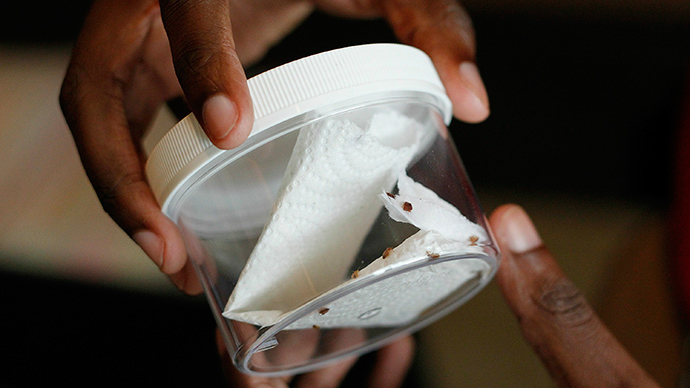Canadian scientists develop trap to lure blood-sucking bed bugs

Scientists from Simon Fraser University in Canada have invented an effective bait-and-trap against bed bugs that uses chemical attractants, or pheromones. In order to test the trap, a team member had to endure up to 180,000 bites from the nasty insects.
READ MORE: Blood-sucking ‘kissing bug’ sees 300k Americans infected with deadly disease
The bait, which the scientists say will be commercially available
next year, turned out to be a real ordeal to develop.
Regine Gries, one of the biologists on the team, discovered the
needed pheromones after acting as a host to thousands of bedbugs
during her research.
“You can feed it on the blood of chickens or guinea pigs, but
that’s not their preferred blood. To get the best results, and
not jeopardize their chemical profiles, it was important to feed
them human blood,” Gries told National Post.
B.C. scientists may have created world’s first effective, affordable bedbug trap http://t.co/nNGqnKDy6zpic.twitter.com/iCteqmiwCz
— The Globe and Mail (@globeandmail) December 23, 2014
Luckily, because Gries is immune to the bites, she only developed
a slight rash – as opposed to the painful itching and swelling
that most people experience.
The insects were largely wiped out after the Second World War,
but have made a comeback, particularly in the US and Canada.
The hardy little bugs can go for months without feeding, meaning
they can lie undetected in furniture and mattresses.
“The biggest challenge in dealing with bedbugs is to detect
the infestation at an early stage. This trap will help landlords,
tenants, and pest-control professionals determine whether
premises have a bedbug problem, so that they can treat it
quickly. It will also be useful for monitoring the treatment’s
effectiveness,” said researcher Gerhard Gries in a news
release on Monday.
New bedbug volatiles and histamine(!) Key to a better bed bug trap? http://t.co/8pJIte5rzc photos:Graham Snodgrass pic.twitter.com/pXtx264K7W
— Ent Soc of Canada (@CanEntomologist) December 23, 2014
When the research began eight years ago, the scientists isolated
a pheromone mix that attracted bedbugs in lab conditions, but not
in actual areas where bed bugs were living. After two years of
research, Gries and SFU chemist Robert Britton discovered the
crucial chemical histamine, which literally signals safe shelter
to the blood-sucking bugs.
The team is now working with Victoria-based Contech Enterprises
Inc. to develop the bed bug trap commercially.













